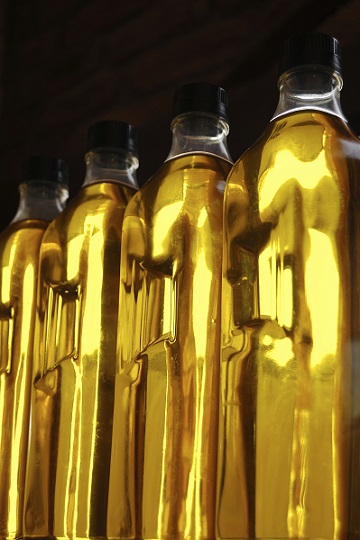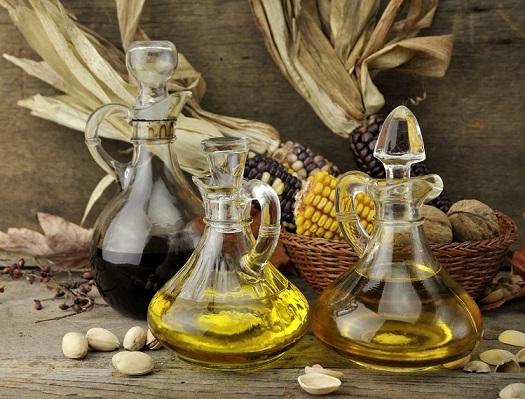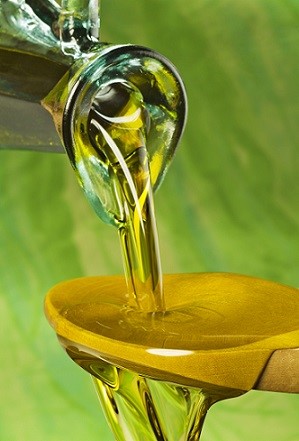
For acne, extra virgin olive oil ties with coconut oil as the number one cooking oil you should roast potatoes with, or drizzle over salad.
For one thing, this oil is bursting with vitamin E, the joint greatest nutrient for acne alongside zinc. Secondly, olive oil is 70% oleic acid, a monounsaturated fat which calms chronic inflammation superbly.
Finally, there’s what olive oil isn’t; it’s free from chemical solvents, rancid fats, and mutated trans-fats thanks to humanity’s 3000-year-old knowledge of cold-pressing it.
Olive oil also contains only 15.5% polyunsaturated fat, compared to 66%, 58% and 55% in sunflower oil, soybean oil and corn oil. Polyunsaturated fats oxidise with impunity when eaten, draining your body of acne-clearing antioxidants.
But here’s something else you should know: olive oil is a highly overrated topical treatment for acne. Like coconut oil or papaya, the story changes completely when you put it on your skin.
Power one – may fade away old acne scars

There’s no denying that olive oil has some decent powers, and the first is accelerating wound healing.
This 2014 study started promisingly, commenting in the introduction that olive oil is popular for wound cleansing in Iran. 24 male, 16 month old mice had all their fur shaved off, and small incisions were made in their skin. The experimental group had their wounds injected with oleuropein, the phenolic antioxidant behind many of olive oil’s heart health benefits.
7 days later, the distilled water accomplished barely anything, but oleuropein increased collagen deposition in the wound significantly, and advanced the pace of re-epithelisation. Collagen is the number one protein involved with wound healing, and importantly for us, this carries over into pimple healing (as well as delayed ageing).
In 2014, a second study from the same team observed improved collagen deposition and more rapid re-epithelisation, and this time, more voluminous blood flow back into the wounds.
Read Annihilate Your Acne – get the ultimate diet and clear your acne permanently!
Oleuropein is accepted to be the signature compound of olive oil, alongside oleocanthal. The signs are clearly positive, but will the stellar results apply to humans? Unless you’re a 16 month old male mouse, then the results aren’t enough for an instant recommendation. What’s more, oleuropein is one compound among hundreds. The great results could be scuppered if a substance like oleic acid turns out to slow wound healing instead. We’d be in better shape if we had studies on collagen and olive oil itself, but alas, we don’t.
Consider cocoa butter, for example. If you tested its natural ceramides on wound healing in isolation, you might conclude that cocoa butter is amazing for acne. But cocoa butter also scores 4/5 on the American Journal of Dermatology’s comedogenic scale, giving it a “high” chance of clogging your skin pores.
Power two – fantastic for vitamin E
That’s a weak positive then, and now we arrive at vitamin E, which is easily olive oil’s most promising feature. Extra virgin olive oil contains 10% of the RDI for vitamin E per tablespoon, which blows most other skincare oils out of the water.
Vitamin E is needed to prevent the oxidation of squalene, a fatty acid which forms 11% of sebum (oil). Oxidised squalene turns into squalene peroxide, perhaps the most ruthlessly efficient pore-clogging substance in nature.
Ordinarily, your body equips all squalene manufactured with strong vitamin E defences, but if your dietary intake is lacking, then applying vitamin E directly will mitigate some of the damage. What’s more, olive oil is rich in oleic acid, which is added to pharmaceutical skincare formulations to improve their penetration into the skin. The same will happen with vitamin E.
Recommended – the top 6 vitamins and minerals for acne-free skin
Sounds good? If olive oil was free from its negative qualities, it would be great enough for me to recommend it enthusiastically.
Argan oil and grapeseed oil are also bombshells of vitamin E, but many of my recommended topical treatments lack it, such as tea tree oil, honey and rose water. Note: read the full profile on grapeseed oil’s greatness here.
Power three – a possible natural sunscreen

Finally, we have some fairly decent studies on inflammation and sunlight defences.
Joining oleuropein as one of the best researched olive oil compounds ever is oleocanthal. This study concluded that 3.4 tablespoons contained enough oleocanthal to match the anti-inflammatory properties of 10% ibuprofen, while this study tested oral oleocanthal, and equalled ibuprofen once again.
This study meanwhile, analysed the little known olive oil compounds erythrodiol and beta-sitosterol. When applied topically to a painfully swollen mouse ear, they reduced the inflammatory swelling by 61.4% and 82.1% respectively. Oleuropein was also tested, and lowered the inflammatory swelling by 30%.
For acne, it’s smart to build up your natural sunlight defenses, because while high exposure can wreak havoc on your skin, you also need moderate exposure to generate vitamin D and nitric oxide.
This study found that olive oil significantly reduced the rate of UVB-induced cancer formation in mice, when applied both before and after UVB exposure. Olive oil was also compared to camellia oil, which had no benefits when applied using an identical propotol.
Another study was less positive, as in 32 human volunteers, neither olive oil nor glycerine increased the minimal erythral dose (MED) after 5 days of regular UV exposure, while petrolatum did succeed. The MED is a useful term to remember for skincare: it’s the lowest concentration of UVB radiation required to mutate and damage human skin cells. Higher is better for acne.
Vitamin E – the ultimate nutrient for clogged pores
Finally, this telling study observed another decrease in tumour formation when olive oil was rubbed in after UVB ray exposure. However, unlike the first study, applying olive oil prior to exposure didn’t work. Olive oil also suppressed a free radical called 9-OHdG, which is generated by sunlight upon contact with human skin cells (this is preventable with antioxidants).
Our conclusion then? It’s a mixed bag, as two of the positive UVB studies were conducted on mice, while the one human study produced strongly negative results. The oleocanthal study is also clouded, because it was purely oral-based rather than topical. That said, the great results were repeated often enough something is clearly happening.
The fatal flaw of olive oil
So why don’t I recommend topical olive oil for any acne patient?
For one simple reason: damage to the human skin barrier, most likely due to oleic acid. That’s a monounsaturated fatty acid responsible for many of olive oil’s famous heart health benefits, such as lowering LDL cholesterol. When consumed, oleic acid can clear acne indirectly by calming inflammation, particularly the vicious chemical interleukin-6 (study).
But when you apply oleic acid to the face, the story flips on its head. As we discussed earlier, oleic acid is a useful skin penetration enhancer, but unfortunately, this power works by destabilising the skin barrier.
Specifically, both olive oil and oleic acid increase trans-epidermal water loss (TEWL), the quantity of water that passes through the outer epidermis and into the atmosphere.
The higher your TEWL score, the dryer your skin becomes. Furthermore, according to this study of 36 mild to moderate acne patients, “the patients with AV exhibited markedly higher sebum secretion and greater TEWL“. The increase in TEWL was particularly noticeable for the severest acne patients.
While the mechanism is unclear, the study blamed an increase in the pore-clogging protein keratin. Oiliness can also increase in direct response to keratin.
The case against olive oil mounts
Why is this important? Firstly, olive oil is proven directly to damage the skin barrier:
ONE: in a study investigating several popular moisturising oils, sunflower seed oil improved skin hydration and barrier integrity, but olive oil significantly reduced barrier integrity after 4 weeks. The scientists commented that “topical treatment with olive oil significantly damages the skin barrier, and therefore has the potential to promote… atopic dermatitis“. Atopic dermatitis is an inflammatory skin condition with strong parallels to acne.
TWO: some rats were treated to increase their TEWL levels. Sunflower seed oil reversed the increase, but olive oil had no benefit (study).
THREE: this study investigated the popular practise of mothers rubbing olive oil into their newborn baby’s skin as a moisturiser. Scientists were worried that the practise might do more harm than good, so they assigned 115 healthy babies to either olive oil, sunflower oil, or no oil twice daily for 4 weeks. While both oils improved skin hydration, they also delayed the development of skin barrier functions in infants which defend against water loss and harmful allergies and infections.
Then they discovered which compound was responsible: oleic acid, which forms 70% of olive oil’s total fats.
FOUR: this 2014 study applied oleic acid, glyceryl trioleate, and a mixture of the two to human skin, and concluded that pure OA inflected the most damage on TEWL and human skin barrier function.
FIVE: when oleic, linoleic, alpha-linolenic, and arachidonic acid were applied to human skin barriers, oleic acid led to the biggest deterioration in TEWL (study).
SIX: in this 2009 study, scientists had already moved to the next level, debating precisely how oleic acid increases TEWL.
SEVEN: this study began with a telling quotation: “Oleic acid (OA) is well-known to affect the function of the skin barrier“. The scientists revealed that oleic acid damaged the function of ceramides, waxy fat molecules which protect the skin.
EIGHT: just 1 hour after application, a combination of oleic acid and propylene glycol increased trans-epidermal water loss significantly (study).
The very fat which makes olive oil such a nutritional powerhouse is exactly the opposite when you rub it into your skin.
Olive oil may be a pore-clogging nightmare

There are other flaws as well. Firstly, olive oil is a fat, and therefore carries an automatic risk of clogging your skin pores.
Olive oil itself is fairly safe, scoring a comfortable 2/5 on the American Journal of Dermatology’s comedogenic ratings. By contrast, coconut oil and cocoa butter score a risky 4 out of 5 each, which is why I strongly recommend against them (though they’re fine as foods).
Nevertheless, 2 still stands for a “moderately low” risk. Many tales from the internet speak of olive oil working like a charm for 5 days, only for new pimples to burst out of nowhere in completely new locations. That sounds suspiciously like new pores were being clogged and giving p.acnes bacteria fresh new breeding grounds. Grapeseed oil and jojoba oil also score a 2, but somehow seem to be safer.
Finally, there’s the looming risk of other sensitivities; this study followed a masseur, who ended up with red eczema on his hands after rubbing olive oil into a customer’s skin. The scientists also spotted skin sensitisation, which could have been caused by slow, insidious skin barrier damage.
Verdict – avoid this topical remedy
Olive oil is excellent for roasting potatoes or pouring onto lettuce, but it fails miserably as a topical treatment. It might prevent inflammation from UVB radiation and accelerate the healing of old acne, but these powers are too weak to counteract oleic acid’s skin barrier mayhem.
Olive oil is undoubtedly outstanding for vitamin E, but this is made pointless by grapeseed oil, which is vitamin E heavy and oleic acid free. If you bought olive oil as a moisturiser but are now disappointed, then grapeseed oil or jojoba oil are far superior alternatives.
Judging by the testimonials and science we’ve just covered, I would advise against using olive oil for more than three days in a row.
NEXT: get the complete strategy for clearing acne naturally
Thanks for reading!

Hi Richard, I’m wondering what do you use to cleanse your face? Soap/ wash and brand, or do you have any suggestions?
Cold water and natural soap (Dr Bronner’s, in very small amounts per cleansing). My main focus is diet and lifestyle. However in the past I’ve used natural treatments and the most effective from my experience was all natural raw honey. Hit the topical treatments link under archives and you’ll find treatments that I do recommend (including aloe vera, tea tree oil and more).
Hi there I love reading your articles, I battle hormonal adult breakouts the jawline area ever since i stopped breastfeeding. i am trying to combat this from the inside out, just incorporating the Zinc and Vitamin D supps alone have helped tremendously although I still get breakouts. I am trying to use different natural topicals like honey and acv, and am currently using oil cleansing to wash off makeup and can assume this is causing me to breakout in comedones and some pustules as I am using Olive oil. Can the grapeseed oil be used in place of this or do you recommend soemhting like jojoba and will it be enough to wipe away grime sweat and makeup? Thanks so much.
Great to hear that you’ve improved so well. I see no reason why grapeseed oil wouldn’t work for make-up and I would definitely recommend ditching the olive oil. Jojoba oil is also good although inferior to grapeseed oil (less vitamin E). I’d stay away from acv though. That’s one of the most fake natural topicals ever; it has a big track record of irritating people’s skin.
Hey Richard.
Absolutely love reading all your articles. You’re a true blessing and helping so many people try to understand what’s causing their grief.
Because of you I’ve quit using harsh topicals prescribed my my derm and threw out my face wash along with my so called “acne prone moisturizing sunscreen”… obviously drastically changed my diet and started eating Brazil nuts and taking a zinc vitamin. I use aloe on my face daily and just purchased some grape seed oil, the buckthorn oil, and thayers which hazel that has aloe in it. I have a big event this weekend and haven’t tried any of which yet, just in case my skin doesn’t agree with the oils.
But anyways! That’s just a little thanks and recognition for all your hard work and knowledge. I am always referring back to you anytime I question something. Which finally brings me to my question! Any suggestions on natural ways to wash my hair? Plain water leaves it obviously greasy and my scalp itchy. Tons of “natural” products still contain unnatural ingredients. My problem is all the truly natural soaps I find (like Zum Bar Soap) are mainly a combination of coconut and olive oils and, since you advise against them as they clog pores I’m worried that as the water washes the soap off my head it’ll run down my face and clog pores. What’s your take on this? I’ve put this off because I didn’t want to pester you but I’ve looked and reasearched for weeks and can’t seem to come across anything.
Would love to hear back. Have a great life.
Can never thank you enough!
Thanks! A combination of coconut oil or olive oil would probably not clog your pores unless you left it on your face for hours. The advocates of coconut oil for natural moisturising recommend rubbing it right into your face, but for a shampoo simply be swift and efficient and you should avoid it. I’ve never heard of zum bar soap but if what you’re using is the goat’s milk product (which I’ve just found) then the ingredients look interesting and safe. In fact, I might do an article on this product because I’ve never heard of anyone using goat’s milk on skin before. Good to hear that you’ve switched to natural topical treatments, but always remember that diet is all-important.
Hello,
I use shea butter for dry skin areas, should I be concerned due to the high oleic content? A lot of oils that seem to highly moisturising, like cocoa butter, coconut butter and mango butter also contain oleic acid.
You have to buy a shea butter from West Africa: varieties from Senegal, Gambia, Nigeria and Burkina Faso. Western varieties of the shea nut are lower in oleic acid and higher in stearic acid. Good choice with shea butter since it has collagen-increasing properties too.
Thank you. Do you recommend any other highly moisturising oil that is a butter like consistency and low in oleic acid?
Hi! How about ozonised olive oil? Would it be safe to try? Seems to be the acne treatment everybody is recommending at least here in Finland. I would love to try it for my acne hyperpigmentation and scars, but am not so sure if it is safe for the skin after reading this post. Does ozonised olive oil have the same problems as normal olive oil?
Hi,
What do you think of Neal’s Yard Rehydrating rose facial oil? It contains hazelnut oil, which like olive, is high in oleic acid. It also contains grapeseed and evening primrose though. Any thoughts?
Hello,
Is olive oil safe to use if low on ingredients list and balanced by other oils with high linoleic acid content?
Thanks!
Absolutely, Mr Dilution, that’s the correct strategy, but make sure that the other oils within that treatment are high quality too. For example: cold-pressed grapeseed oil rather than hexane-extracted.
Is it okay to use Dr Bronner’s Baby Balm as a moisturizer, which contains olive oil but also has other acne clearing ingredients in it? I do a lot of swimming in a chlorine pool so I think this moisturiser would sure help my dried out skin.